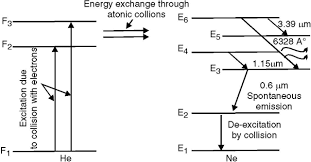Working of Helium Neon Laser
In the last article, I have explained the construction of helium neon laser. Today let us discuss the working of helium-neon laser:
Pumping of He atoms: When electric discharge is passed through the gas mixture of He and Ne, electrons are accelerated down the discharge tube in which mixture of He-Ne is placed. These accelerated electrons collide with helium atoms and excite them to higher energy levels (let us say F2 and F3).

These levels happen to be Metastable and thus the He atoms spend a sufficient amount of time there before getting de-excited.
Achievement of population inversion of Neon atoms: Some of the excited states of Ne atoms correspond approximately to the same energy of the excited levels F2 and F3 of He. Thus, when He atoms in levels F2 and F3 collide with the Ne atoms in the ground state E1, then energy exchange takes place and this results in the excitation of Ne atoms to the levels E4 and E6 and de-excitation of the He atoms to the ground level F1. As the helium atoms have longer life time in excited states F2 and F3, thus this process of energy transfer has high probability.
Therefore, the electric discharge through the gas mixture continuously populates the Ne excited levels E4 and E6. This helps to create a state of population inversion between the levels E4 (or E6) and lower energy levels E5 and E3. Therefore the purpose of He atoms is to help in achieving a population inversion in the Ne atoms.
Achievement of laser: The following three transitions will occur:
E6 to E5 with laser wavelength of 3.39 μm or 33900 Angstroms.
E6 to E3 with laser wavelength of 6328 Angstroms.
E4 to E3 with laser wavelength of 1.15 μm or 11500 Angstroms.
The wavelengths of 3.39 μm and 1.15 μm correspond to the infrared region and wavelength 6328 Angstroms corresponds to the red light wavelength (visible region).
Mirrors of the optical resonators are so designed to show low reflectivity for wavelengths 3.39 μm and 1.15 μm. Thus photons of these wavelengths will be eliminated. Therefore, the photons of wavelengths 6328 Angstroms will move back and forth in the optical resonator system and thus laser of wavelength 6328 Angstroms emerges through the partially reflected mirror.
The excited Ne atoms drop down from levels E3 to E2 through spontaneous emission and this process will emit a photon of wavelength 0.6 μm. As the level E2 is also Metastable, there is a probability of excitation of Ne atoms from E2 to E3 leading to quenching of the population inversion. To eliminate quenching, the narrow discharge tube is used because Ne atoms are de-excited to level E1 from E2 through collisions with the walls of the tube.
Note: In next article, I will explain the output, uses, and drawbacks of He-Ne laser. Till then, try to make the working diagram. In case of any problem in this article or any other physics article, post in the comment section
Following is the link to our youtube video about the working of Helium-Neon laser :
thank you . by reading this post I feel like a winner and that after losing big time on my physics homework. thank you for taking the time and effort to share science with the world.
thanx, after reading this, i feel great, it’s so easy to understand what u write…
Thanks avinash.
If you like it, then you can share with it your friends.
NYC ONE,
FULLY INFORMATIVE
Thanks
Thanku so much it help me alot to clear my doubts and to understand difficult topic. I always prefer this website for clearing doubts and understand topic. Once again thanku so much
Thanks. If you like our website, please share with friends.
Well, i feel more a biomedical engineer now reading this, i have enjoyed it so much..thank you